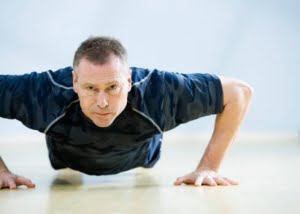 Few things are as universally recognized as contributing to overall health as is exercise. Whether you are six or sixty, health care professionals tell us that exercise is an important factor in weight control, maintaining muscle tone, keeping our cardiovascular systems operating at peak function, and many other crucial aspects of health. But for older folks, there are a number of concerns that ought to be kept in mind before deciding upon an exercise routine.
Few things are as universally recognized as contributing to overall health as is exercise. Whether you are six or sixty, health care professionals tell us that exercise is an important factor in weight control, maintaining muscle tone, keeping our cardiovascular systems operating at peak function, and many other crucial aspects of health. But for older folks, there are a number of concerns that ought to be kept in mind before deciding upon an exercise routine.
The first is that as we age, our bodies change. While this may not exactly be news to anyone 40 or older looking in a mirror every few years or so, important changes are taking place beneath the skin that we should all be aware of.
Among the changes brought on by aging are:
- The Heart….quite simply, as we age our maximum heart rate decreases, as does the maximum amount of blood the heart can pump. This can have a significant impact on endurance; and more exercise will not improve the older heart’s ability to move more blood as it does with younger people;
- The Lungs…as with the heart, with age our lungs lose some capacity and some of their ability to move oxygen into the bloodstream. This is another reason why older people seem to get tuckered out more quickly than younger people do when they physically exert themselves.
- Muscles…as we age, we lose both muscle strength and muscle mass. Muscle rejuvenation also changes as we age, so that exercise will increase muscle bulk, but not strength.
- The Nervous System…this is an important consideration that many people might not at first think is immediately associated with exercise, but it is a fact that with age comes a decline in the flow of blood to the brain. This, in turn, is directly associated with reaction time. When combined with the diminished sense of balance associated with aging, it becomes clearer that some exercises may pose an additional risk to older people.
While exercise remains one of the best things you can do to maintain your health as you age, it is important to remember that your body probably has limitations that it didn’t have ten or more years ago. Statistics show, for example, that older athletes are much more likely to injure themselves than younger athletes playing the same sport or undertaking the same motions.
One final consideration also has to do with how active a person has traditionally been over the last several years. People who have remained active are less likely to overdo it or hurt themselves than couch potatoes whose exercise has generally been limited to working the TV remote control for the last few years.
Several experts suggest that older people consider one or more of the following types of exercise to help keep in shape and stay healthy:
- Walking: as simple as it sounds, just walking can help keep the body toned and the blood moving; brisk walking is even better. Similarly, taking the stairs instead of the elevator, where feasible, can also be a small, quick and easy contribution to your daily routine;
- Swimming: the best part about swimming is that it gives the muscles and cardiovascular system a workout while not putting an undue strain on the joints or skeleton. It is a great way for older people to help maintain weight and muscle tone;
- Aerobics: this form of exercise improves muscle tone and strength, strengthens the respiratory system, improves blood circulation, and is easy to do;
- Yoga: surprising though it may be, this ancient form of exercise can help reduce stress levels, lower blood pressure, improve flexibility and provide relaxation.
It is never too late to start exercising again. If you are concerned about how much exercise you should undertake, consult your physician. For most older people, however, exercise should be a part of their daily or weekly routine. If you’d like more information on exercise and aging, we invite you to contact Capital EAP. We’d be glad to help.
